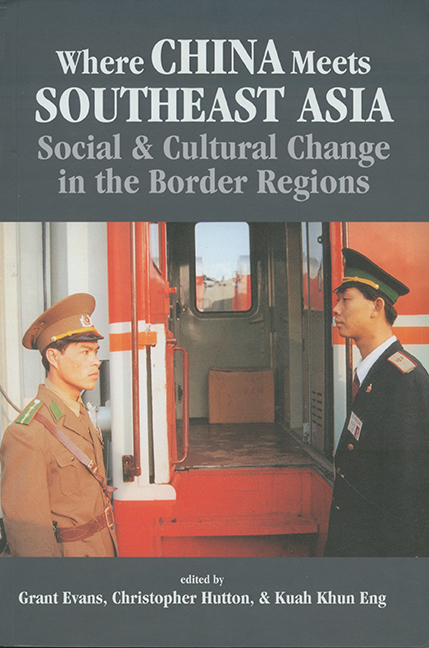Book contents
- Frontmatter
- Contents
- Contributors
- Map
- Introduction: The Disappearing Frontier?
- 1 Where Nothing Is as It Seems: Between Southeast China and Mainland Southeast Asia in the “Post-Socialist” Era
- 2 The Southern Chinese Borders in History
- 3 Ecology Without Borders
- 4 Negotiating Central, Provincial, and County Policies: Border Trading in South China
- 5 The Hmong of the Southeast Asia Massif: Their Recent History of Migration
- 6 Regional Trade in Northwestern Laos: An Initial Assessment of the Economic Quadrangle
- 7 Lue across Borders: Pilgrimage and the Muang Sing Reliquary in Northern Laos
- 8 Transformation of Jinghong, Xishuangbanna, PRC
- 9 The Hell of Good Intentions: Some Preliminary Thoughts on Opium in the Political Ecology of the Trade in Girls and Women
- 10 Cross-Border Mobility and Social Networks: Akha Caravan Traders
- 11 Cross-Border Links between Muslims in Yunnan and Northern Thailand: Identity and Economic Networks
- 12 Trade Activities of the Hoa along the Sino-Vietnamese Border
- 13 Cross-Border Categories: Ethnic Chinese and the Sino-Vietnamese Border at Mong Cai
- 14 Regional Development and Cross-Border Cultural Linkage: The Case of a Vietnamese Community in Guangxi, China
- 15 Women and Social Change along the Vietnam-Guangxi Border
- Index
Introduction: The Disappearing Frontier?
Published online by Cambridge University Press: 21 October 2015
- Frontmatter
- Contents
- Contributors
- Map
- Introduction: The Disappearing Frontier?
- 1 Where Nothing Is as It Seems: Between Southeast China and Mainland Southeast Asia in the “Post-Socialist” Era
- 2 The Southern Chinese Borders in History
- 3 Ecology Without Borders
- 4 Negotiating Central, Provincial, and County Policies: Border Trading in South China
- 5 The Hmong of the Southeast Asia Massif: Their Recent History of Migration
- 6 Regional Trade in Northwestern Laos: An Initial Assessment of the Economic Quadrangle
- 7 Lue across Borders: Pilgrimage and the Muang Sing Reliquary in Northern Laos
- 8 Transformation of Jinghong, Xishuangbanna, PRC
- 9 The Hell of Good Intentions: Some Preliminary Thoughts on Opium in the Political Ecology of the Trade in Girls and Women
- 10 Cross-Border Mobility and Social Networks: Akha Caravan Traders
- 11 Cross-Border Links between Muslims in Yunnan and Northern Thailand: Identity and Economic Networks
- 12 Trade Activities of the Hoa along the Sino-Vietnamese Border
- 13 Cross-Border Categories: Ethnic Chinese and the Sino-Vietnamese Border at Mong Cai
- 14 Regional Development and Cross-Border Cultural Linkage: The Case of a Vietnamese Community in Guangxi, China
- 15 Women and Social Change along the Vietnam-Guangxi Border
- Index
Summary
The chapters for this book were all written in headier days — not too long ago — when the “Asian Economic Miracle” was still riding high. When words like “free-wheeling” and “dynamic” were bandied about freely, conveying a sense of limitless investment opportunities and a new age of growth which would soon overflow into general affluence, and further down the line, human rights and democratic freedoms.
But even then people knew that there was an underside to the Asian dream: official corruption, environmental havoc, the exploitation of marginal or vulnerable social groups (migrant workers, rural women, children, ethnic minorities), the appropriation of land, the spread of drug abuse, prostitution. This was a vision of capitalist greed backed by state controls, a nightmare world in which the worst of capitalism meets the worst of Stalinism, where workers locked in at work die in factory fires, border guards are drug smugglers and forestry officials are loggers and poachers.
The Asian economic crisis that began with the collapse of the Thai baht in mid-1997, along with the pall of haze which hung across Southeast Asia as a result of the enormously destructive forest fires in Indonesia, swung attention to the downside of the seemingly fast-fading miracle. International commentators now focus on the effects of corruption and cronyism in government across the region, and there is an embarrassed silence about the earlier upbeat assessments.
The chapters in this volume, all written during the final heydays of the “Tiger Economies”, are neither enthralled by the “miracle”, nor do they simply focus on its downside. Instead, they all convey a rare understanding of the complexity of the changes engulfing the region. Indeed, the chapter by Hinton, “Where Nothing Is as It Seems”, is not only a careful critique of many of the conceptualizations of the changes in the region. It is also a statement about how difficult it is to conceptualize such diverse changes, and diverse capitalisms (rather than some fictitious, singular “Asian capitalism”), and he warns us about how easy it is to be smug in retrospect.
- Type
- Chapter
- Information
- Where China Meets Southeast AsiaSocial and Cultural Change in the Border Regions, pp. 1 - 6Publisher: ISEAS–Yusof Ishak InstitutePrint publication year: 2000



